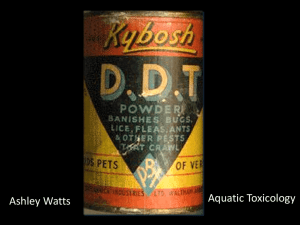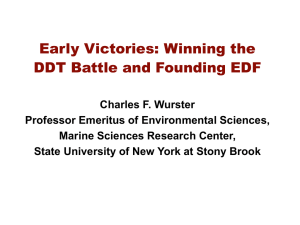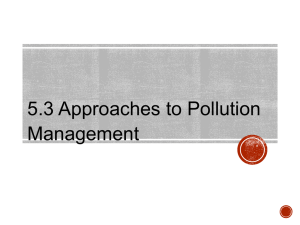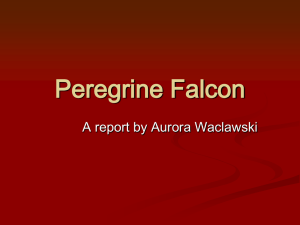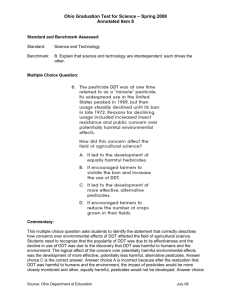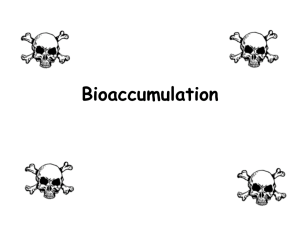Pollutants in food chains: impacts on birds
advertisement
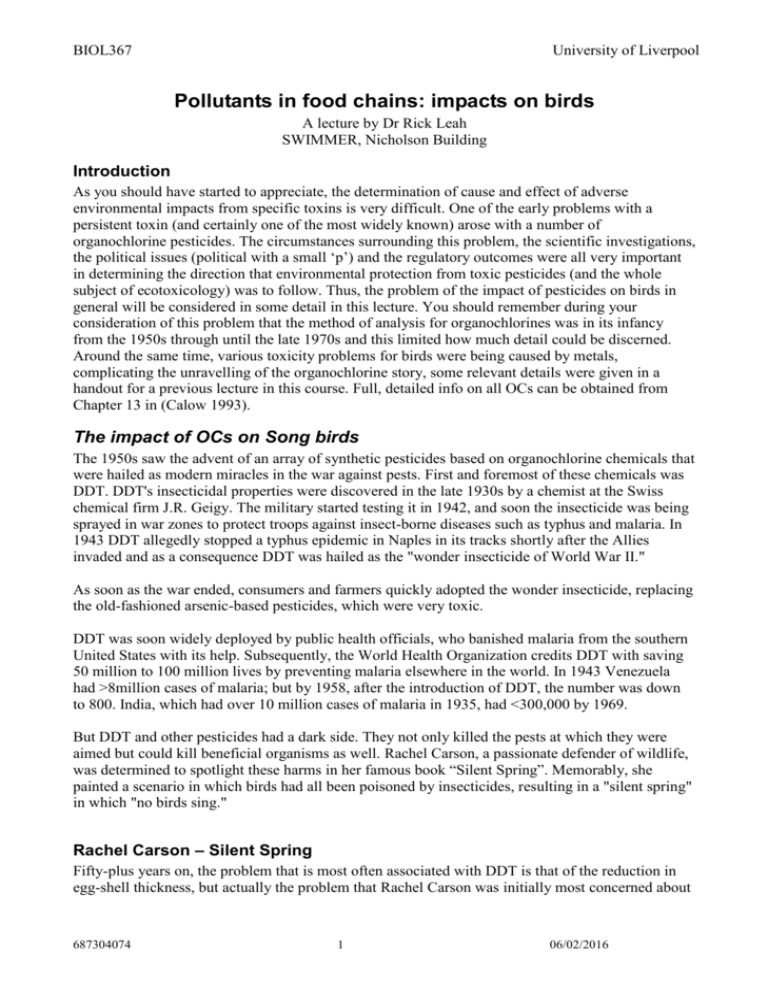
BIOL367 University of Liverpool Pollutants in food chains: impacts on birds A lecture by Dr Rick Leah SWIMMER, Nicholson Building Introduction As you should have started to appreciate, the determination of cause and effect of adverse environmental impacts from specific toxins is very difficult. One of the early problems with a persistent toxin (and certainly one of the most widely known) arose with a number of organochlorine pesticides. The circumstances surrounding this problem, the scientific investigations, the political issues (political with a small ‘p’) and the regulatory outcomes were all very important in determining the direction that environmental protection from toxic pesticides (and the whole subject of ecotoxicology) was to follow. Thus, the problem of the impact of pesticides on birds in general will be considered in some detail in this lecture. You should remember during your consideration of this problem that the method of analysis for organochlorines was in its infancy from the 1950s through until the late 1970s and this limited how much detail could be discerned. Around the same time, various toxicity problems for birds were being caused by metals, complicating the unravelling of the organochlorine story, some relevant details were given in a handout for a previous lecture in this course. Full, detailed info on all OCs can be obtained from Chapter 13 in (Calow 1993). The impact of OCs on Song birds The 1950s saw the advent of an array of synthetic pesticides based on organochlorine chemicals that were hailed as modern miracles in the war against pests. First and foremost of these chemicals was DDT. DDT's insecticidal properties were discovered in the late 1930s by a chemist at the Swiss chemical firm J.R. Geigy. The military started testing it in 1942, and soon the insecticide was being sprayed in war zones to protect troops against insect-borne diseases such as typhus and malaria. In 1943 DDT allegedly stopped a typhus epidemic in Naples in its tracks shortly after the Allies invaded and as a consequence DDT was hailed as the "wonder insecticide of World War II." As soon as the war ended, consumers and farmers quickly adopted the wonder insecticide, replacing the old-fashioned arsenic-based pesticides, which were very toxic. DDT was soon widely deployed by public health officials, who banished malaria from the southern United States with its help. Subsequently, the World Health Organization credits DDT with saving 50 million to 100 million lives by preventing malaria elsewhere in the world. In 1943 Venezuela had >8million cases of malaria; but by 1958, after the introduction of DDT, the number was down to 800. India, which had over 10 million cases of malaria in 1935, had <300,000 by 1969. But DDT and other pesticides had a dark side. They not only killed the pests at which they were aimed but could kill beneficial organisms as well. Rachel Carson, a passionate defender of wildlife, was determined to spotlight these harms in her famous book “Silent Spring”. Memorably, she painted a scenario in which birds had all been poisoned by insecticides, resulting in a "silent spring" in which "no birds sing." Rachel Carson – Silent Spring Fifty-plus years on, the problem that is most often associated with DDT is that of the reduction in egg-shell thickness, but actually the problem that Rachel Carson was initially most concerned about 687304074 1 06/02/2016 BIOL367 University of Liverpool was the killing of songbirds after spraying campaigns. One classic example of the problem was the mortality of large numbers of American Robins (Turdus migratorius) after a campaign to eradicate Dutch elm disease. Convincing evidence for cause and effect (actually carried out on the campus of the University of Wisconsin) was presented by Hickey & Hunt (1960). Undoubtedly, Carson’s book initiated the era of environmental activism that resulted in the banning of pesticides such as DDT. However, her intervention was controversial, partly because she was not deeply knowledgable about the science of toxicology and that the adverse environmental impact of DDT was not very great set against the death and destruction brought about by insect vectors of disease. Partridges The common (or grey) partridge (Perdix perdix ) was observed to be in decline in various parts of the world after the second World War. Eighteen years of intensive study in Sussex, England were summarised and world wide trends in their populations were analysed in a book by GR Potts (1986). The causes are tied up with changes in agriculture in general, not just with the use of a specific herbicide. The main problem is mortality of chicks and the cause of this has long been of considerable controversy among game keepers and ecologists. Both weather and the availability of insect food could be important, particularly as partridge chicks can only produce about one third of the body heat that they need to survive a critical phase of growth, the rest coming from brooding by parent birds. In cold weather, time away from parents may be limited leading to starvation but despite many attempts to correlate chick production with summer weather but none of these have accounted for more than a small amount of the variability. Laboratory studies have shown that insects are nutritionally necessary for growing chicks and in the Sussex study, there was a good relationship between chick mortality and the density of preferred insects (see fig 2). Distinction between the effects of insect availability and weather was achieved by multiple regression. This showed that 48% of the variation in chick mortality was explained by the density of preferred insects and an extra 10% by temperature in the critical period June – July. If insect availability is key to Partridge population dynamics, was the decline caused by pesticide usage? Herbicide usage is probably more important than direct impact of pesticides by causing reductions in preferred insect species but there is another interaction – that with gamekeepers. This was examined by putting the key data from the Sussex study into a simple model of population dynamics – the use of gamekeepers would reduce the rate of decline but not enough to stop eventual extinction. Only by ceasing the use of herbicides to increase the food supply of insects and thus reduce the mortality rate of chicks could the situation be altered. A similar hypothesis that a reduction in invertebrate abundance is likely to have had a detrimental effect on the house sparrow (particularly on nestling development/survival)has been put forward very recently to explain the decline of the house sparrow (Passer domesticus) ( Vincent 2005). The House sparrow is now listed as a UK Priority Species, following the recent UK review (Biodiversity Reporting and Information Group (BRIG), 2007) and red listed in UK Birds of Conservation Concern (Gregory et al., 2002) due to its recent population decline. 687304074 2 06/02/2016 BIOL367 University of Liverpool Fig 1 Importance of insect food for chicks Fig 2 Indirect effects of herbicides on weeds 687304074 3 06/02/2016 BIOL367 University of Liverpool Fig 3 Fig 4 Fig 5 687304074 4 06/02/2016 BIOL367 University of Liverpool Raptors The Peregrine Falcon DDE + eggshell thinning During the 1950s representations were made to the British Home Office by racing pigeon enthusiasts concerning the losses caused by peregrine falcons preying on their birds. They were lobbying for a change in the protected status of the peregrine because they claimed that the peregrine population had greatly increased increasing their losses. As a result of this pressure, the Nature Conservancy was asked to undertake a nationwide survey which revealed that the peregrine population had declined greatly and that less than one-fifth of the remaining birds successfully raised young in 1961 and 1962. The report on this study generated a lot of activity in the USA. A team surveyed peregrine populations in eastern North America, travelling 22,500 km and visiting 133 known eyries in 1964 and found every single eyrie deserted. This finding was the spur for an international meeting to examine the contemporary population changes of the peregrine and other birds of prey. The meeting was held at Madison, Wisconsin, in 1965 (Hickey, 1969). The data presented at the meeting showed that the species was effectively extirpated in eastern North America and had decreased markedly in many countries in Europe. In Scandinavia, the population was reduced to only 5% of its pre-war population by the early 1970s. In Germany, the number of breeding peregrines had decreased from 400 pairs to 40 pairs by 1975. Before the controversy broke out (during the early 1950s) Derek Ratcliffe of the Nature Conservancy (in the UK) found what he considered to be an abnormal number of broken eggs in the eyries of the peregrine in several regions of the British Isles. If egg breakage had become more common, it was likely that the thickness of eggshells had become thinner. Using museum specimens, Ratcliffe examined the temporal variation in peregrine and sparrowhawk eggshells collected in the UK since 1900 and his findings that a pronounced decrease in eggshell thickness occurred in both species in the mid-1940s were published in Nature in 1967. Ratcliffe's data for the peregrine over the critical period of change (with some more modern data added) are shown in figure 6. The first sign of change in eggshell thickness was in 1946, although the mean was not statistically significant. In 1947, the change was clear and statistically significant, and in the decade that followed eggshells as thick as the pre-war norm were a rarity. The most dramatic case of eggshell thinning was found in the brown pelican (Pelecanus occidentalis) off the coast of California in 1969. The colony on Anacapa Island showed almost complete reproductive failure, with only four chicks raised from some 750 nests. Most nests were abandoned and remains of crushed eggshells were found throughout the colony. On average, the thickness of these broken and crushed eggshells was only half of the normal value. The reproductive failure of the colony continued for the next few years. The productivity of double-crested cormorant (Phalocrocorax auritus) colonies was also close to zero and, again, the main cause was the breakage of the eggs. The most detailed studies on eggshell breakage were made by the Canadian Wildlife Service on colonies of cormorants on Lake Huron in 1972 and 1973 (Weseloh et al., 1983). These 687304074 5 06/02/2016 BIOL367 University of Liverpool Fig 6 workers visited all the known colonies of cormorants in Lake Huron. They found that 79% of the eggs were ‘lost’ within 8 days of laying and that by the end of the normal incubation period only 5% of the eggs remained in the nests. In about half the cases of ‘lost’ eggs, eggshell fragments were found in or around the nest. The eggshells averaged 24% thinner than pre-war values; although this is not as severe as that found in California, it was enough to cause almost complete reproductive failure. The reduction and subsequent recovery of this population will be discussed in the lecture on the Great Lakes of North America, later in this course. The importance of the North American findings was that there clearly was a linkage between reproductive failure and eggshell thinning (Risebrough and Peakall, 1988). Analytical work revealed that DDT (and its metabolites) and PCBs were the only contaminants present in appreciable amounts. In this, the situation is quite different from that in the UK where dieldrin was found to be a major additional factor in population declines of peregrine and sparrowhawk. The original hypothesis was developed that a pesticide was responsible for eggshell thinning on the grounds that the effect occurred at the time that synthetic pesticides were introduced on a large scale and the declines in population were greatest in areas where pesticides were most heavily used. The analysis of residues of organochlorine pesticides was becoming more widespread by this time and by the beginning of the 1970s it was possible to show a correlation between the levels of DDE (note that it was the breakdown product, not the pesticide itself) in the egg contents and the thickness of the shell (figure 7). This particular dose-response curve shows that, initially, a low concentration of DDE causes a large response and that the response tends to 'flatten out' with increasing dose. These findings established a correlation between the concentration of DDE and the degree of eggshell thinning. Experimental studies with the American kestrel established a cause and-effect relationship. Further, it was demonstrated that the relationship between the degree of eggshell thinning and DDE residue levels in the egg based on laboratory studies was the same as that found in the field. These studies also showed that PCBs did not cause eggshell thinning. 687304074 6 06/02/2016 BIOL367 University of Liverpool Fig 7 There was a major legal battle over DDT in 1971. It was the first pesticide over which environmental regulations were made and the producers feared, with some justification, that if they lost this battle they would lose others. The hearing that led to the ban of DDT in the USA was the most extended and bitterly fought ever conducted on an environmental contaminant. It ran from August 1971 to March 1972 and a total of 125 expert witnesses produced over 9000 pages of testimony. There were four batteries of lawyers. On one side, there were those representing the chemical industry (27 companies acting together as group petitioners) and the lawyers of the US Department of Agriculture; on the other side, those representing the US Environmental Protection Agency and the Environmental Defence Fund. Observations of eggshell thinning linked to DDT were important evidence in this hearing. Despite the verdict going against DDT (and other similar ones in other countries), there was criticism of the finding. Because eggshell thinning had occurred so rapidly after the introduction of the insecticide, before it was widely used, it was argued that DDT could not have caused this effect. It was indeed true that all the work was carried out some 1020 years after thinning had first been shown to occur; the first measurements were made on the levels of DDE in peregrine eggs in 1962, whereas eggshell thinning started in 1946. However, so stable is DDE and so sensitive are analytical techniques that it proved possible to extract enough DDE from the dried membranes of eggs collected over the critical period (1946-7) to demonstrate that enough DDE was present to have caused eggshell thinning. Fig 8 687304074 7 06/02/2016 BIOL367 University of Liverpool It was soon found that the phenomenon of eggshell thinning in peregrines was global and that there was a close correlation between the degree of eggshell thinning and the health of the peregrine population. Studies from Australia, Europe and North America showed that when eggshell thinning exceeded 17-18% population declines followed. The relationship between eggshell thinning and the status of populations is shown in figure 9. Four extirpated populations had eggshell thinning of 1825 %, declining populations had over 17 %, whereas stable populations had less than 17% thinning. Fig 9 Cyclodienes The cyclodienes proved to be very toxic to wildlife. Aldrin and Dieldrin were the first to be widely used. Aldrin is actually converted to Dieldrin in the field. Other similar pesticides in the same family were Heptachlor, Chlordane & Endrin. Food chain accumulation, pigeons, seed dressings, deaths, foxes and raptorial birds Implicated as carcinogens – removed from food chain 1970s & 80s Some minor use continued in other countries for specialised problems 687304074 8 06/02/2016 BIOL367 University of Liverpool Sparrowhawk Fig 10 Fig 11 687304074 9 06/02/2016 BIOL367 University of Liverpool As would be expected, there was considerable interest in the mechanism whereby DDE caused eggshell thinning. A wide variety of mechanisms have been proposed. However, the finding that eggshell thinning of up to 50% occurred in the brown pelican indicates that the site of impairment is in the shell gland, as reduction of 50% of calcium levels throughout the organism would cause profound physiological changes. This hypothesis is supported by the finding that the circulating level of calcium in the blood is normal in birds laying eggs with thin shells. There is now general agreement that it is transport of calcium across the eggshell gland mucosa that is affected by DDE. Decreased activity of Ca-ATPase and effects on prostaglandins have been proposed as the key mechanisms. There is no reason to suppose that these mechanisms are mutually exclusive. However, no comprehensive answer to the mechanistic basis of species variation of DDE-induced eggshell thinning has been put forward. Fig 12 The evidence that DDT and dieldrin was causing widespread decreases in several populations of the peregrine and many other birds of prey was part of the evidence that led to bans and restrictions. The use of DDT and dieldrin was banned in the Scandinavian countries over the period 1969-72, and in Holland dieldrin was restricted in 1968 and DDT was banned in 1973. In Great Britain, there were voluntary restrictions on both DDT and dieldrin starting in 1962, although some small scale uses were not banned until 1986. The approach in Great Britain was the opposite to that in the USA, where the ban on DDT imposed in 1972 followed a long court hearing. In the eastern United States and southern Canada, the peregrine had disappeared completely by the early 1960s. In these areas, reintroduction was the only feasible means of restoring the population. Large-scale breeding programmes, with the intention of raising birds for reintroduction, were started by the Canadian Wildlife Service at Wainwright, Alberta, in 1972 and by the Peregrine Fund at Cornell University, New York, at about the same time. The first few captive-raised young were released in 1975 and the numbers released soon increased. The first breeding attempt of released birds in the wild was in 1979 and the progress has been rapid since then. We have now reached the point where releases are needed only in a few specific areas. In other parts of the world, some breeding stock remained and reintroduction programmes were not essential. Recovery has occurred in Alaska, western Canada, the continental United States and Mexico, starting in the later 1970s. In the British Isles, where the most detailed data are available, recovery was described as 'virtually complete in overall numbers, though not in precise distribution'. In other parts of Europe, the populations have increased, but are still low compared with pre-war numbers, notably in the Czech Republic, Slovakia, East Germany and Poland, which formerly held large populations. These, and other, recoveries of the peregrine are detailed in Cade et al. (1988). 687304074 10 06/02/2016 BIOL367 University of Liverpool An interesting aspect of the phenomenon of eggshell thinning is the wide difference in the sensitivity of different avian species. Most sensitive are the raptors and the fish-eating birds; this is unfortunate as it is these species that are exposed to the highest dose as a result of the bioaccumulation of DDE up the food chain. The raptors, in addition to the peregrine, that have shown marked effects include the osprey (Pandion haliaetus) and the bald eagle (Haliaetus leucocephalus) in North America and the sparrowhawk in Europe. In contrast, the species most commonly used in in vivo toxicity tests (quail, pheasant, chicken) are almost completely insensitive; and others (such as the duck) are only moderately sensitive. Thus, it is unlikely that even the studies conducted now before registration of a new pesticide would have detected this particular adverse effect of DDT. However, other negative aspects of DDT, such as its strong tendency to biomagnify up the food chain and its toxicity to fish, should prevent registration. No story is quite as tidy as one would like. Although in many parts of the world it seems clear that DDT-induced eggshell thinning was the main cause of population declines of raptorial birds, in some areas other pesticides were certainly also involved. In the UK, direct mortality caused by dieldrin, another organochlorine that is magnified up the food chain, is considered to have been the most important factor , whereas in North America the levels of dieldrin recorded were well below the critical value. Fig 13 The eggshell thinning story is one of the most comprehensive environmental investigations that has been completed during the short history of environmental toxicology. An important feature of eggshell thinning and the subsequent collapse of the populations of the peregrine and other birds of prey lies in the fact that the effects occurred over a wide area, much of it remote from the place of application of the pesticide. 687304074 11 06/02/2016 BIOL367 University of Liverpool References Cade, T. J., J. H. Enderson, et al. (1988). Peregrine populations: Their management and recovery. Boise, ID., The Peregrine Fund Inc. Calow, P. (1993). Handbook of ecotoxicology. Oxford, Blackwell Scientific. Hickey, J. J. (1969). "The peregrine Falcon Populations: Their Biology and Decline." Univ Wisconsin, Madison, USA. Hickey, Joseph J.; Hunt, L. Barrie. (1960) Initial Songbird Mortality Following a Dutch Elm Disease Control Program The Journal of Wildlife Management, Vol. 24, No. 3. (Jul., 1960), pp. 259-265. Stable URL: http://links.jstor.org/sici?sici=0022541X%28196007%2924%3A3%3C259%3AISMFAD%3E2.0.CO%3B2-O Potts, G. (1986). "The Partridge: Pesticides, predation, conservation." Collins. London. Risebrough, R. and D. Peakall (1988). The relative importance of the several organochlorines in the decline of Pregrine Falcon populations. Peregrine populations: Their management and recovery. T. J. Cade, J. H. Enderson, C. G. Thelander and C. M. White: 449-468. Weseloh, D., S. Teeple, et al. (1983). "Double-crested cormorants of the Great Lakes: egg-laying parameters, reproductive failure and contaminant residues in eggs, Lake Huron 1972-1973." Canadian Journal Of Zoology 61: 427-436. 687304074 12 06/02/2016
